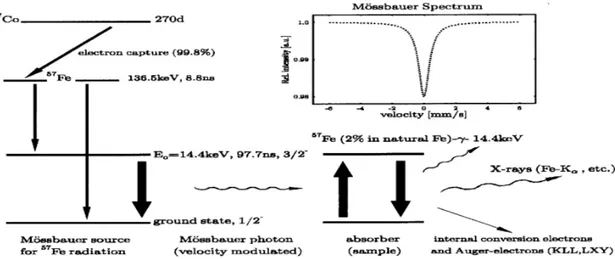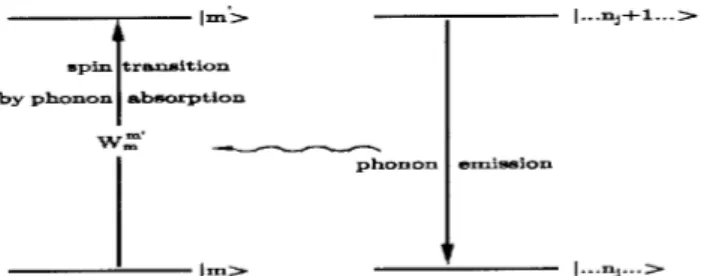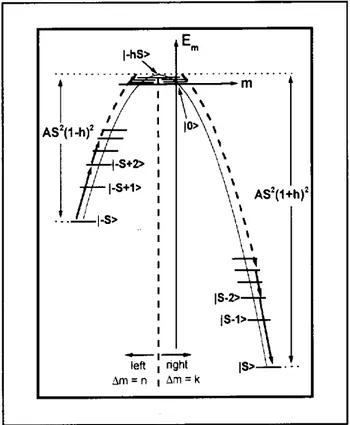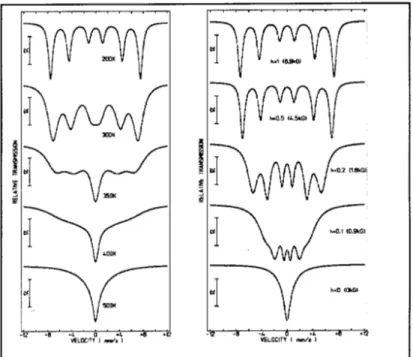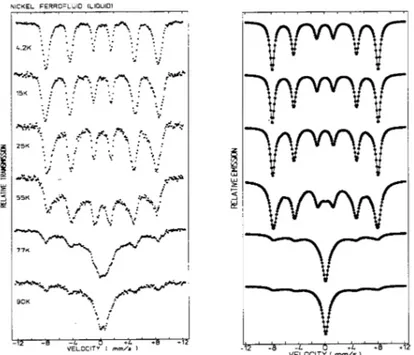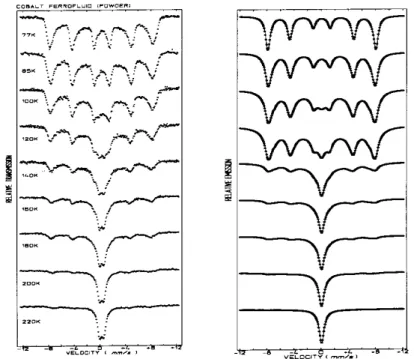Mossbauer Spetrosopy,
Superparamagnetism and Ferrouids
H.-D. Pfannes, J. H. Dias Filho,R. Magalh~aes-Paniago,
J. L. Lopez, and R. Paniago
LaboratoryforHyperneSpetrosopyandSurfae Physis
Departamento deFsia,UniversidadeFederaldeMinasGerais,BeloHorizonte,Brazil
Reeivedon21Deember,2000
SomefundamentalsofMossbauer spetrosopyand ofutuatingmagnetihyperneinterations
are reviewed. Anexpression for alulationof spin-phononinterationtransition probabilities on
thegroundofaDebyemodelisgiven. Basiideasofsuperparamagnetismandlassial resultsfor
low-temperature relaxationrates are presented. A theoryof superparamagnetismbased on
spin-phononinterationisintrodued. ItisshownhowtoalulatefromthisMossbauerspetrataking
allspin-levelsintoaount. Experimentalspetraofferrouidsareomparedwithsimulatedspetra
andfoundingoodaordane.
I Introdution
The Mossbauer eet is based on the \reoilless"
ab-sorption and emission of low energy (E
0
=10-100keV)
-photonsin solids[1,2℄. Asimpleexplanationforthis
eetreliesontheHeisenbergunertaintyrelation: the
unertaintyin momentump~=xofboundatoms
isoftheorderof10 23
kgms 1
(x=0:1
A)butthe
re-oilmomentofe.g. a-photonwithenergyE
0
=10keV
is smaller(~510 24
kgms 1
),i.e. thereoilwhih
eventuallyanexitevibrations(phonons)ofthe
emit-ting atomsometimesmaynotbemeasurable. The
re-oil is then transmittedto the rystal asawhole and
sinethe massof therystalis muh greaterthan the
atomi mass it does not alter the -energy
(\reoil-less"emission). TheMossbauerradiationemittedfrom
a Mossbauer soure has thereforethe exatresonane
energyneessaryforabsorptioninanabsorber
ontain-ing the same material as the soure. Moreover,when
the lifetime of the exited Mossbauer energy level
is longer (e.g. = 10 7
s) than the inverse vibration
(phonon) frequenyoftheemittingor absorbingatom
(e.g. 10 13
s)theatom arriesoutmanyylesduring
thelifetimeandtheDopplerbroadeningoftheemitted
radiation averages out. As a result a sharp line with
the natural linewidth = ~= at the position E
0 is
emittedfromthesoureandnulearresonane
absorp-tion with an energeti resolution =E = 10 13
,
suf-ient toresolvehyperne interations,is possible[2℄.
Theabovementionedonditionsforreoillessemission
limitsthe Mossbauer isotopesto those isotopeswhih
possess low energy nulear -transitions (small reoil
moment),longlifetimes oftheexitedstate(hyperne
resolution), high Debye temperature (small x) and
solidsouresand absorbers. These onditionsare
ide-allyfullled for 57
Fewhihisindeed themostpopular
Mossbauerisotope. Fig. 1showsshematiallythe
de-ayshemeof 57
Co,whihisused asparentfora 57
Fe
Mossbauersoure. TheMossbauerresonantabsorption
andvarios re-emissionsare alsoindiated in Fig.1. In
order to vary the energy of the Mossbauer radiation
emitted by the soure in the rangeof hyperne
ener-gies and thus renderpossibleMossbauer spetrosopy
itissuÆienttomovethesourewithsomemm/s. The
intensityoftheMossbauerphotonsbehindtheabsorber
asfuntion oftherelativeveloitybetweensoureand
absorber represents a Mossbauer (transmission) sp
e-trumasshownshematiallyintheinsertofFig.1.
I.2 Hyperne Interations
Theinterationoftheextendednulearhargewith
eletronspresentinthenulearvolumeleadsto ashift
of the enter of the spetrum (isomer shift) and
pro-videsinformationonthevalenestateoftheMossbauer
Figure1. Deayshemeof 57
CoandMossbauerresonaneabsorptionandre-emissionof 57
Fe. Insert:Mossbauertransmission
spetrum.
An eletri eld gradient present at the nuleus'
siteinteratswith thenuleareletriquadrupole
mo-mentandresultsina(quadrupole)splittingofasingle
Mossbauer line (into two lines for nulei with nulear
spinof theground and exitedstates, I
g;e
=1=2;3=2;
respetively). This nulear quadrupole interation
al-lowsonlusionsonthevalene,bondingpropertiesand
symmetryoftheviinityoftheMossbaueratom.
Themagnetihyperneinterationisespeially
im-portantin ourontext. Themainpartofitstemsfrom
the Fermi ontatinteration whih is the interation
ofthenulearmagnetidipolemomentwithanet
spin-upordowns-eletrondensityatthenuleus. Itanbe
representedbyaspin-Hamiltonian[2℄
H
mhf =
~
S $
A ~
I; (1)
where $
A
is the hyperne tensor. Whenthe hyperne
tensor is isotropi, i.e. H
mhf = AS
z I
z
with the
hy-perneinterationonstantA,wean interpretitasa
nulearZeemaneetduetotheeldB
n
atthenuleus'
site(innereld)
H
mhf
= gn
B B
n
I: (2)
ForaMossbauerisotopewithI
g;e
=1=2;3=2a
six-linespetrumwithrelativeintensitiesdependingonthe
angle between the -diretion and the z-axis results.
Thepreseneofsixlinesina 57
FeMossbauerspetrum
thusindiates thepreseneof a(stati) magnetield
atthenuleuswhihmaybeausedbylongrangeorder
magnetism.
I.3 Flutuating hyperne elds
Flutuationsofthehyperneinterations analter
thespetra. E.g. whenB
n
hangesit'sdiretionmany
times during the lifetime of the exited state the
nu-leus\sees"onlyanaveragezeroeldandthesplitting
It an be shown that the Mossbauer absorption
spetrumI(!)observedin theenergy(frequeny)
do-main, i. e. the numberof ounts in transmission
di-retion behind the absorber asfuntion of the soure
veloityv,is givenbythereal partofthetraeof the
spetrum of the temporal orrelation funtion of the
Mossbauerradiation operatorA (e.g. magneti dipole
radiation)as[3,4℄
I(!)= 2
Re Z
1
0 dte
pt
Tr(A(t)A +
(0)); (3)
wherep= =2 i!(E
0
=~!=E
0
v=)andisthe
den-sityoperator of thewhole system. It is advantageous
here to use superoperators and Hamilton
superopera-tors H x
(Liouville operators) in order to avoid time
ordering problems when H(t) is not ommuting with
itself at dierent times as is the ase when ombined
nulearquadrupoleand(non-diagonal)magneti
hyper-neinterationispresent. AsuperoperatorA x
atson
another operator B in the form A x
B = A +
B BA
whihis equalto theommutator[A;B℄whenthe
op-erator A is hermitian. TheLiouville operators anbe
represented in aprojetor base jij)=ji >< jj of the
Hamiltonianeigenstatesji>andjj>andthe
eigenval-ues of H x
are the spetrosopi important dierenes
(E
i E
j
). The produt (BjA) is given by (BjA) =
Tr(B+A)andthetimeevolutionA(t)ofanoperatorA
anbewrittenexp(iHt)Aexp( iAt)=exp(iH x
t)A(0):
Weanthenwrite [4℄
I(!)= 2
ReTr
A 1
p iH x
A +
= 2
ReTr Z
1
0 dte
pt
e iH
x
t
A(0)A +
(0); (4)
HereapratialdiÆultyarises: H x
omprisesthe
in-fyingapproaheshavebeenused: thestohastiandab
initiomodels. Wepresentheresomeideasonthelatter
model.
TheHamiltonian ofthesystemissubdivided
H =H
Ion +H Bath +H Ion Bath : (5)
One shows then that under the assumptions
H x Bath Ion << H Ion ;H Bath
(onvergeny of
approx-imation solution) and =
Ion
Bath
(irreversible
Bath-Ioninteration)theMossbauerspetrumisgiven
by[4,5℄
I(!)/ReTr
Ion ( Ion A[p iH x Ion R(p)℄ 1 A + ); (6)
wheretherelaxationsuperoperator Rontainsmatrix
elements of thespin-operator S
q
and bath orrelation
spetraldensities whih dependon bath-operatorsF
q .
Here the ion-bath interation was desribed by a
dy-namial spinHamiltonian H
Ion Bath = P q S q F q :E:g: in 2 nd
order of H x
Ion Bath
after some tedious
alu-lation one obtains asrelaxation supermatrix elements
[5℄ (ge)jR jg 0 e 0 ) = X q;q 0 " Æ gg 0 X e" <e 0 jS q 0
je"><e"jS
q je>I
0 q 0 q (! g ! e +ip) + Æ ee 0 X g" <g 0 jS q
jg"><g"jS
q 0jg
>I"
q 0 q (! g" ! e +ip) <e 0 jS q
je><gjS
q jg
0
>I"
q 0 q (! g 0 ! e +ip) <gjS q 0 jg 0 ><e 0 jS q je>I"
q 0 q (! g ! e 0
+ip)℄ (7)
d
withthereservoirorrelationspetraldensities
I 0 q 0 q ()= Z 1 0 e it Tr Bath [ Bath F I q 0(t)F I q (0)℄dt I 00 q 0 q ()= Z 1 0 e it Tr Bath [ Bath F I q (0)F I q 0(t)℄dt (8)
where the bath operators F I
q;q℄
are in the interation
representation. WhenI 0
q 0
q andI"
q 0
q
areindependentof
! (\whitenoiseapproximation",normallyvalid in the
ase of spin-phonon relaxation), the matrix elements
(egjR jeg) are transition probabilitiesW e
g
between the
statesje>andjg>:
I.4 Spin-phonon interation
Simplifying, we start with a dynamial
spin-Hamiltonianwhihrepresentsthespin-phonon
intera-tionin2 nd
orderperturbationtheory(B q 2 areoupling onstants)[6,7℄ H Bath Ion = 2 X O q 2 B q 2 ( av + 2 av
+:::) (9)
withtheaveragedstrainoperator
av = X j ~ 2M! j 1=2 k j (a + j e i ~ k j ~r +a j e i ~ k j ~r ): (10)
TheequivalentoperatorsO q
2
ontaintheladder
op-eratorsS 2
. Wetakeonlydiretproessesintoaount
(seeFig.2)wheretheabsorption(annihilation)or
emis-sion(reation)ofaphononleadsto aspintransition.
Figure2. Spinexitation by absorption of aphonon ina
diretproess.
The spetral bath orrelation density an then be
alulatedintheharmoniapproximationby
introdu-ing the Debye model. In the long-wavelength limit
(! = vk) we obtain ( = M=V = density, v =
I 0
(2)
q 0
q =I
"(2)
q 0
q =
3(!
m 0
!
m )
3
B q
0
2 B
q
2
4~v 5
1
e ~(!
m 0
!
m )=k
B T
1
(11)
andthespin-phonontransition probabilities(f. Fig.2)are
W m
0
m =
3(B p
1 )
2
j<m 0
jO p
1 jm>j
2
2~v 5
(E
m 0
E
m )
3
exp((E
m 0
E
m )=k
B T) 1
: (12)
d
Withthese relationsparamagneti spin-phonon
re-laxation spetra of e.g. Fe(III) impurities (S = 5=2)
anbe alulated,eventuallyusing eetivespins-[5℄
beause the supermatrix for S = 5=2 has already a
rankof(2I
g
+1)(2I
e
+1)(2S+1) 2
=288for 57
Feand
is not hermitian. An example for Fe(III) impurities
in monorystals of LiNbO
3
is given in [8℄. For
big-gerspinslikethatorrespondingtothetotalmagneti
moment of magneti nanopartiles (S = 1000-10000)
the rankof thesupermatrix involved would be of the
orderof10 8
,withoutanypossibilityofnumerial
treat-ment. But itis yet possible to realizealulationsfor
bigspinswhenonlydiagonalinterationispresentand
thusnosuperoperatorformalismisneededforthe
om-binedstohasti-quantum mehanialproblem (see be
belowin setionII.4).
II Superparamagnetism
Superparamagnetismhasto do withthethermally
in-dued inversion of the magnetization of small
(nano-sized) magneti partiles. This is an important
phe-nomenonsineultra-nemagnetipartilesare
impor-tant in many systems, e.g. in soils, roks, argiles,
e-ramis, paintings, living organisms (ferritin, magneti
bateria, magnetially based navigation of animals),
reording media (what is the ultimate magneti
stor-agedensity?),atalysts,et. andferrouids.
II.1 Basi ideas of superparamagnetism
Whenthe dimensionsof asmall magneti partile
are of theorder of the width of aBloh wall the
par-tile willbeasingledomainpartile. Atlow
tempera-turesthe spinwavesare frozenandthus the
magneti-zation is equalto thespontaneous magnetization M
s .
Sine the exhange (or superexhange) interation is
predominant ompared to anisotropyinterations jMj
mayberegardedasonstantsothattheonlydegreeof
freedom ofthe magnetization would beitsorientation
relative to some (uniaxial) anisotropy axis. When
measuring aproperty related to the magnetization at
T > 0 it may happen that the magnetization
utu-ates(thermallyativated)betweeneasydiretions and
theharateristitime ofmeasurementisgreaterthan
the(overbarrier)utuationtimeofthemagnetization.
In this ase we say that superparamagneti behavior
ismeasured(themeasurementmethod \sees"onlythe
time-averagedvalue). Fromnowonwewillusethe
fol-lowing simpliations: only an uniaxial symmetry of
theform[9-12℄
E()=KVsin 2
M
s
VBos (13)
is present (K = anisotropy onstant, V = volume of
thepartile),theexternaleldB isparalleltothe
pos-itivez-diretion,allpartilesare identialin material,
form and spatial orientationand are uniform (no
sur-fae eets) and isolated (no partile-partile
intera-tion)andtherotationofthemagnetizationhappensby
oherentrotationofthespins(\unison"). Underthese
irumstanesvarious authorsdedued expressionsfor
therelaxationtime ofreversionsofthemagnetization
betweentheeasyz-diretions.
Neel[11℄relatesthevibrationalstrainenergyofthe
partilestoitsthermalenergyandalulatesthe
mag-neti energy aused by thedeformation. Atlow
tem-peratureheobtains
1
Neel
=(2K =G) 1=2
0 M
1
s
j3G+DM 2
s j
1=2
(1 h 2
) 1=2
(1h)exp( (1h) 2
is the gyromagneti ratio, = KV=k
B
T and h =
BM
s
=2K isthereduedexternaleld (0h1):
Brown[12℄ onsidersarandom walkofthe
magne-tization on a sphere similar to Brownian motion. In
the lassial equation of motion of the magnetization
(Gilbert'sequation)adissipativeandrandomeldterm
h(t) is introdued. A Fokker-Plank equation is
ob-tained whih is approximately solved. The result for
lowtemperature(<<1)is
1
Br
(
0 K =
1=2
M
S
)(1 h 2
)(1h)exp( (1h) 2
):
(15)
Thisexpressioniswidely usedintheliteraturebut
it'snotvalidforhightemperaturesandh1.
Bessais, Ben-Jael, Dormann [13℄ nd more
ex-at solutions of the Fokker-Plank equation by using
FourierandChebyshevseriesand dedue
1
BBD
=K
0 M
S
(1+=4) 5=2
1
exp( ): (16)
Villain et al. [14℄ analyzeparamagneti like
relax-ation in magnetimoleules withS =10 due to
spin-phononinteration. Theorrespondingrelaxationrate
wasalulatedto
1
V 3B
2
(KV) 3
(2~ 4
v 5
S 4
) 1
exp( ): (17)
Jones, Srivastava [15℄ introdue the \many states
model"inordertoalulateMossbauerspetra(see
be-lowinsetionII.4). Foralarge(lassial)spin
(ontin-uumlimit)theyalsodeduefromthismodelaF
okker-Planklikeequationandsolveitinthelowtemperature
regime andobtain(R/squareofarandomeld)
JS
1 R 1=2
3=2
(1 h 2
)(1h)exp( (1h) 2
):
(18)
One observes that all these expressions ontain
the same Arrhenius-like exponential fator but
vari-ous prefators. In priniple they are only valid in
the low temperature regime. No mirosopi,
non-phenomenologial explanation of the
superparamag-netimehanismisgivenbytheaboveauthors.
II.2 Superparamagnetism by
spin-phonon relaxation
Reentlyamehanismforsuperparamagneti
relax-ation based on spin-phononinteration was suggested
[16℄. Weshortlyrepeatherethemainideasandresults
ofthiswork.
The supposed unison rotation of the spins
sug-gests the attribution of a large spin to the
magneti-zation dened by M
s
V = g
B
S. Relating Sos to
the spinoperator S
z
and suppressing aonstant term
KV,theanisotropyenergy(13)orrespondsto a
spin-H
sp
= AS 2
z g
B BS
z
; (19)
wheregistheeletronig-fator,
B
theBohr
magne-tonandAS 2
=KV (heightofthebarrier for B =0).
Thesuperparamagnetirelaxationofthepartilesis
as-sumedtobeinduedbyinterationofthelargespinS
withthephononsof thepartile(or ofabath). In
or-der to turn overbetween opposite easy diretions the
spin S must pass through intermediate levels
hara-terizedby S
z
. Eigenvetorsof (19)are jS
z
>=jm >,
with eigenvalues E
m
= AS
2
z
2AhSS
z for S
z =
S; S+1;:::;S 1;S: Fig. 3 shows a graphof E
m
vs. m and a possible phonon indued spintransition
betweenthelowestlevelsofbothsidesofthebarrier.
Figure3. Anisotropy energyvs. eigenvalueswith applied
magnetield. Spintransitionsfromj S >to jS>with
m=n=2areindiated.
II.3 Calulation of a relaxation time for
jS>$j S >
Thespintransitionrateinduedbyphononsisgiven
in(12). ConsideringonlytherelaxationjS>$j S>
under the ondition that the oupation of all
in-termediate levels remains onstant (pseudo two level
system) and assuming detailed balane, a rate
equa-tionssystem(masterequations)anbeestablishedand
solved for a relaxation time
[16℄. In the ase of
spin jumps with m = n = 2 we obtain (C 0
=
(3(B
1 p)
2
=2~ 4
v 5
)(AS 2
) 3
;
=(1h) 2
)
1
=C
0
1
exp(
)(S=2)
6
(h)= S 2 (1h) 1 X i=0 exp 2 S 2 i 2 1 exp 2 S 2
(1+2i)
(1+2i) 3
(S(1h 2i)(S(1h) 2i 1)D)1h)+2i+2(S(h)+2i+1)
: (20)
Agoodapproximationuptoh0:95is
1 5C 0 1 (1 h 2 ) 2 exp(
)210 13 s 1 1 (1 h 2 ) 2 exp( ): (21) d
HereS =3222,=5000kgm 3
, v=3000ms 1
and
KV =AS 2
=2:6710 20
J wasassumed,whihare
typ-ialvaluesfora90
AMnFe
2 O
4
-partilewith5spinsper
unit ellof 8.4
A lattieonstant[16,17℄. Fortheonly
freeparameter, theouplingparameterB 2
2
, avalueof
13m 1
washosen,whihresultsinrelaxationratesin
aordanewiththeexperiments.
The funtional dependene on the anisotropy
en-ergyKV, temperatureT and external eld (h)in the
expressions(14)-(18)and(21)issimilar. Theyontain
the sameArrhenius-like fatorand dieronly slightly
in theelddependeneof thepre-fator,whihis
pro-portionalto(1 h 2
)(1h) in(15)and(18)insteadof
(1 h 2
)(1+h)(1 h)in(21). Inviewoftheompletely
dierent physial approah used this may be
remark-able. Of ourse all the expressions dier in the other
fators whih appear in the pre-fator sine they
de-pendontheparametersinvolvedinthespei model.
We onludethat our model adequately desribes
su-perparamagnetism.
Onthebasisof(21)Mossbauerspetraanbe
al-ulated using an eetive spin. At low temperature
experimental spetraan bereprodued [17℄. Spetra
atsomewhathighertemperatureanapproximately
re-produedtakingolletiveexitations,i. e. athermally
averagedinner eld, intoaount. Howeverforhigher
temperatures this method fails andalulations based
onthemethodpresentedinthefollowingareindiated.
II.4 Multi-levelalulation of Mossbauer
spetra
In the ase of isotropi magneti hyperne
in-teration and diagonal nulear Hamiltonian (nulear
quadrupoleinteration<<magnetihyperne
intera-tion)theexpression(6)and(7)anbesimpliedsothat
no superoperators are needed. Furthermore one an
simulate a Mossbauer spetrumby summing upthree
separately alulatedspetraonsisting ofthepairsof
lines (1-6), (2-5),(3-4) in thesix-lines spetrum. The
simpliedexpression[15℄ foronepairoflinesreads
I(!)/2Re( ~ W $ M 1 ~
I)whit $
M=(i(! !
i )+ ) $ 1 $ R; (22) where $ W
is a row vetor onsisting of probabilities
(Boltzmannfators)ofthe(2S+1)statesandM
on-tainsthestatiline positions!
i
,givenbythesplitting
(1-6),whihis assumedtobeproportionalto S
z . The
relaxationmatrix $
R
hasaselementstransition
proba-bilitiesr
ij =W
ij
betweenthestatesji>!jj >(i6=j)
andr ii = P j W j I
(i6=j). ThetotalMossbauer
spe-trum is obtainedby summingup the three alulated
two-lines spetra (1-6), (2-5) and (3-4), where in the
alulationofthe!
i
adequatelyreduedsplittings(2-5)
and(3-4),stillproportionaltoS
z
,andthesame
transi-tionprobabilitiesasinthealulationof(1-6)areused.
Asbefore, for thespin-transitions S
z
=2is
pre-sumed. We taketherefore only spin-matrix elements,
that ontainS 2
, into aount,whih resultsin
transi-tionprobabilities W Sz2 S z =C(B=m 1 ) 2 S 4 1 S z S 1 S z S 1 S 1 S z S + 1 S 1 S z S + 2 S (4AS) 3 1 S Sz S h 3 e 4AS k B T ( 1 S S z S h) 1 : (23) S z
W
x /exp
KV
k
B T
(1+h) 2
S
z
S +h
2 !!
: (24)
Introduingtheseexpressionsin (22)onean
simu-late Mossbauer spetra. The inverse of $
M
is required
foreahvalueof!(256Mossbauerveloities),involving
aorderof256timesN 3
operationsforamatrixofrank
N. Inourase $
M
istridiagonalandthusonlyofthe
or-der of256N 2
operationsareneessaryforinversion. A
further signiantsavinginomputertimeisobtained
by observing that in (22)in fat not theinverse $
M 1
$
M ~
V =1problemisreduedto solveaset of
simulta-neouslinearequationsforwhihrequiresonlyanorder
of256Noperations[15,18℄. This methodallowsone to
simulatespetraforspinsSuptoseveralthousand,
or-respondingtospinsfoundinrealsystems,onamodest
omputerinafewminutes.
Fig. 4showssomesimulationsofspetrausingthis
multi-level relaxation method for a spin S = 3222 at
dierent temperatures and several external magneti
elds. The parametersused in the alulationsof the
transitionprobabilitiesarethat ofeq. (21).
Figure 4. SimulatedMossbauer spetraatdierenttemperaturesandzero externaleld (left)and dierent eldsat600K
(right). Seetext.
Despitetheabovedesribedpossibilityofrapid
sim-ulationofspetraforalargespinitmaysometimesbe
neessary to use a smaller (redued) spin in order to
alulate real spetra. E. g.,if thesimulationof
pow-derspetraisdesired,onehastoeetanaverageover
the dierent orientations ofthe rystallitesrelativeto
theexternaleld- and-diretion. Thisimpliesin the
presene of a eld omponentperpendiular to the
z-axis, whih results in amixture of the spin levels, so
that $
M
is no longer tridiagonal. Furthermore, when
size-dispersionis present, asis alwaysthe asein real
samples,onehasalsotosumupsuÆientlyspetra
or-responding to dierent volumes (and anisotropy
on-stantvalues K, whih often depend on the rystallite
size).
Figure5. VariationofS;S=3222,322,32(simulationtime
Weomparedthereforespetrasimulationsfor
dif-ferentvaluesS
red
of reduedspinsatdierent
temper-atures. The resultis shownin Fig. 5. It an be seen
thatpratiallyidentialspetraareobtainedfor
dier-entspinswhenthetemperatureisreduedbyafatorof
approximatelyS=S
red
. Oneanthereforeuseasmaller
spinS
red
inpratialsimulations.
III Appliation to ferrouids
Many ferrouids are based on nano-sized partiles of
ferrites. Stati Mossbauer spetraof ferritesan
nor-mally be satisfatorilyttedby twosextetswith
rela-tivetotalareaorrespondingtotheratioof 57
Featoms
onotahedralandtetrahedralsubstitutionalsites(Neel
model[19℄). However,forsimpliationof the
alula-tions,weuseinthefollowingsimulationsonlyonesingle
sextetwithlarger(0.4mms 1
)linewidthandsuppress
also thequadrupole splitting. Inthe alulationsalso
thesizedistribution(log-normaldistributionwithmean
diameterd
0
andwidth )asdeduedfromthesample
synthesisandeletronmirosopyhasbeentakeninto
aount by summing up spetra (sample synthesisby
F.A. Tourinho, UnB, Brasilia). The random
orienta-tionofthenanopartileshasbeenountedforbyusing
relativeline intensities in the sextetsof 3:2:1. Fig. 6
showsexperimental spetraofaNiFe
2 O
4
basedfrozen
ferrouid in the temperature range T = 90...4.2K.In
theorrespondingsimulationsaredued spinS
red
de-pendingontherystallitediameterd(sizedistribution)
denedbyS
red
(d)=S(d
0 )(d=d
0 )
3
withS(d
0
)=32and
reduedtemperaturesT
red =T(S
red
=3222)wereused.
Similarly, Fig.7 shows experimental spetra and
simulations of a powder of CoFe
2 O
4
, preursor of a
obaltferrite based ferrouid. The simulations have
been doneanalogouslyto those of Fig.6. Considering
thevarioussimpliations madetheoinideneof
ex-perimentalandsimulatedspetraissatisfatory.
IV Conlusion
Experimental superparamagneti Mossbauer line
pat-ternsarereproduedbyab-initiosimulationsbasedon
aspin-phononinterationmodelandtaking
intermedi-atespinlevelsintoaount,withoutusingathermallly
averaged hyperne eld due to olletive exitations.
We use spin-transitionsprobabilities pertime W j
i
de-rived from a dynami spin-Hamiltonian (weak
spin-bath interation) that indues transitions in the spin
andphononsubsystemsandadopt theDebyemodelin
thelongwavelength limit.
WiththismethodoneisabletoalulateMossbauer
spetra for S=3222 within several minutes (provided
thattherelaxationmatrixRistridiagonal)onasmall
personal omputer. Comparison of spetra alulated
with a smaller spin exhibit similar shapes than that
of the\real" spinS, providedthe temperatureis
ade-quately redued. Simulations ofMossbauer spetraof
ferrouids-ferrites areompared with real spetraand
showgoodorrespondene.
Figure6. SpetraoffrozenNiFe2O4-ferrouid,d0=10nm(left)andsimulationswithSred(d0)=32andreduedtemperatures,
log-normalsizedistribution(=0.1, d06=10nm),K=410 4
Jm 3
Figure7. CoFe
2 O
4
-powderspetra,d
0
=4.3nm(left). CoFe
2 O
4
-simulations,d
0
=5nm,=0.1,S(d
0
)=32,K=1:610 5
Jm 3
,
(right).
Referenes
[1℄ R.L.Mossbauer, Z.Physik151,124(1958);
Naturwis-senshaften 45, 538 (1958); Z. Naturforsh. 14a, 211
(1959).
[2℄ V.I. Goldanskii, R.H. Heber, Chemial appliations of
Mossbauer Spetrosopy, Aademi Press, New York,
1968.
[3℄ S.Dattagupta,G.K.Shenoy,B.D.DunlapandL.Ash,
Phys.Rev.B16, 3893(1977).
[4℄ L.Cianhi,P.Moretti,M.ManiniandG.Spina,Rep.
Progr.Phys.49,1243 (1986).
[5℄ H.D.Pfannes,Hyp.Interat.110,127(1997).
[6℄ R.Orbah, H.J. Stapleton, in: Eletron Paramagneti
Resonane,ed.S.Geshwind(PlenumPress,NewYork,
1972).
[7℄ K.K.P.Srivastava,S.N.Mishra,Phys.Stat.Sol.(b)100,
65(1980).
[8℄ H.-D Pfannes, R. Magalh~aes-Paniago, E. Bill, A. X.
Trautwein,Hyp.Interat.94,2005 (1994).
[9℄ S.Mrup,J.A.Dumesi,H.Topse,in:Appliationsof
Mossbauer Spetrosopy, Vol. II,ed.R.L.Cohen
(Aa-demiPress,NewYork,1980).
[10℄ J.L.Dormann,RevuePhys.Appl.16,275(1981).
[11℄ L.Neel,Ann.Geophys.5,99(1949).
[12℄ W.F.Brown,Jr.,Phys.Rev.130,1677(1963).
[13℄ L. Bessais, L. BenJael, J. L. Dormann,Phys.Rev.
B45,7805(1992).
[14℄ J.Villain, F. Hartmann-Boutron, R. Sessoli, A.
Ret-tori,Europhys.Lett.27,159(1994).
[15℄ D.H.Jones,K.K.P.Srivastava,J.Mag.Magn.Mat.78,
320(1989).
[16℄ H.-D.Pfannes,A.Mijovilovih,R.Magalh~aes-Paniago
andR.Paniago,Phys.Rev.B62,3372 (2000).
[17℄ H.D.Pfannes,J.H.DiasFilho,J.L.Lopez,S.L.Pereira,
P.C. Morais, F.A. Tourinho, Hyp. Interat. 113, 507
(1998).
[18℄ H.-D.Pfannes,J.H.DiasFilho,R.Magalh~aes-Paniago
andR.Paniago,J.Mag.Magn.Mat.(2001)inthepress.
